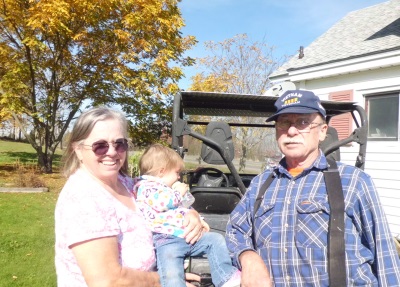Wayne Coleman of Maine

What makes them outstanding?
Wayne and Peggy Coleman own approximately 108 acres in Bailyville, most of it wooded, and have been practicing exemplary stewardship for the past 20 years. The Colemans have contracted two well managed commercial harvests in the past, as well as conducted several small harvests commercial harvests his own with the help of his sons.
In addition to revenue, these harvests have produced firewood, wildlife habitat, water quality control, and recreational opportunities.
Wayne and Peggy frequently host community events with church groups, scouts, and the St. Croix chapter of SWOAM (Small Woodland Owners Association of Maine).
Wayne and Peggy are being awarded Maine Tree Farmer of the year for the first time, and has been awarded Washington county Tree Farmer of the year twice.
Tree Farmer Story
Wayne and Peggy Coleman first bought their first property in 1987. Wayne, an Oil Burner repairman, made the wise move from NJ to Maine where there was a strong demand for heat.
He and his wife currently reside on the property. He raised 4 sons. Currently, the property is officially owned by Coleman Family Living Trust. One of Wayne's sons has and his Daughter in-law both have associates degrees in forestry from the university of Maine in Fort Kent. Their children (Wayne's Grand children) LOVE to play in Grampa's woods.
The Colemans objectives for forests management include sustainable yield of forest products, firewood production, recreational access, Wildlife habitat, and water quality protection.
Wayne and his sons have actively harvested timber for firewood and commercial sale of pulp and sawtimber. He has had two commercial harvests since he has owned the property, and he has participated in several cost share programs.
Wayne is an active participant in the St. Croix chapter of SWOAM and his local church. He has hosted several tours on his woodlot for SWOAM, his church, and boy scouts.
Wood
Wayne's primary objective is to provide long term, sustained yield of forest products. He and his sons harvest between 12 and 20 cords of firewood a year. Occasionally he sells his own wood commercially to the local pulp mill. He does this with a 36 HP Kabota tractor with a farmi winch. Wayne proudly uses snatch blocks and as much cable as he can to limit his impact in the woods. To provide for additional access, Wayne obtained a backhoe in 2010.
In addition to wood harvested for his personal use, Wayne has hosted two commercial harvests- one cable skidder operation in 1995, and a cut to length operation in 2007. Of the two, Wayne prefers the modern means of low impact CTL equipment.
Wayne estimates he has generated Over $40,000 in the last 15 years between the value of firewood and his commercial harvesting.
Water
As mentioned previously, Wayne purchases a backhoe to improve access and upgrade drainage structures throughout his property. Many of his trails of ditches now. He has even revitalized a "rock culvert" constructed the original settles of his homestead.
Wayne has actively sought NRCS cost share funding for some of his drainage work. His property actually contains acreage in two major river drainage's- the St. Croix river and the Machias river. When the NRCS funding "Dried Up" after farm bill delays, Wayne still went ahead and did what he could with his own time and money to improve drainage and water quality.
Wildlife
Waynes property contains one of the finest Oak groves in Washington county. Oak is quite rare in this part of Maine and Wayne's harvesting is especially gears to oak management. Waynes property has been well known as a deer hotspot throughout town. He also has planted several chestnut trees, and rehabilitated all the wild apple trees he could find. Wayne doesn't hunt anymore, but hes very happy to see his woodlot being actively used by wildlife.
Recreation
Wayne's claim to fame lies in his excellent woodlot access. His trails access (within reason) every part of his property. These trails are constructed for walking and light machinery so both recreation and forest management can occur simultaneously.


